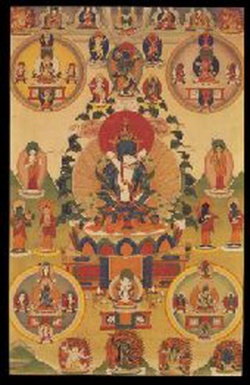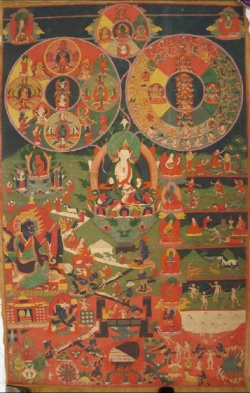Questions About Death By Roger
1. How long do we go through the Bardo state and do we have awareness while at that state?
The Bardo thodol
The bardo is know as the "in-between state" of awareness. This concept appears the Hinayana and Mahayana writings around the second century. The concept originally explains that there is a state of being that connects the death of an individual with his following rebirth. This concept was further elaborated in the Vajrayana teachings. In the Naro chodrug and in the Bardo thodol, six kinds of in-between states were differentiated: (1) the bardo of birth (2) dream bardo (3) bardo of meditation (4) bardo of the moment of birth (5) bardo of supreme reality and (6) bardo of becoming. While the first three bardos characterize the present life as a phase of "suspended states," the last three bardos encompass the forty-nine day long process of death and rebirth.
The best source of information on the bardo states is the Bardo thodol. This text is known in English as the "Tibetan Book of the Dead." The book is composed of a list of instructions by Guru Padmasambhava, that were elaborated into a systematic teaching in the form of a religious text in the 14th century.
The process of death and rebirth is set forth in this book as three phases or in-between states, which are closely connected with the three bodies of the Buddha (the Trikaya). In the bardo of the moment of death, a dazzling white light manifests; in the bardo of supreme reality, lights of five colors appear in the forms of mandalas; in the bardo of becoming, a light phenomena of lesser brilliance appear that correspond to the six modes of existence.
All three phases offer the possibility, through hearing the appropriate instructions, for a being to recognize the nature of his own mind and to attain enlightenment. If a person does not succeed in identifying with this experience, he falls into a state of unconsciousness for three or four days, during which time a so-called consciousness body is formed, which is the subject of the experiences to come. In the following bardo of supreme reality, which lasts fourteen days, the consciousness perceives the forms of forty-two peaceful and fifty-eight wrathful deities. These appear as part of the unfolding of a mandala.
If the consciousness body fails to recognize that these light appearances are its own projections, then the twenty-eight day long bardo of becoming begins. In the first three weeks of this in-between state, the consciousness relives its previous deeds, and in a matter of corresponding to the development of that process, is prepared for the search, during the last seven days, for a new life in the six realms of rebirth. For more detailed information, please read The Tibetan Book of the Dead by Evans-Wentz.
2. Why do ghosts and the likes come back to Earth if they are supposed to be in the Bardo state?
According to Buddhism, ghosts are beings whose karma is too good for rebirth in the hell worlds, but not good enough for rebirth in the divine, human or animal world. Greed, envy, and jealousy can, according to the traditional view, lead to rebirth as a preta (hungry ghost). Pretas suffer the torment of hunger, because their bellies are immense but their mouths are only as big as the eye of a needle. Sometimes pretas come into this world because they are very confused, and they want to experience human life again.
3. Is it (the bardo state) the same kind of awareness we have now while we are alive?
No. The experiences are more sublime and sensorial.
4. What is the difference between being there (in a bardo state) and being on earth. It would seem to be better if we don't have to eat, sleep or go to work while in the Bardo state. Why do people want to reincarnate to Earth if we still have the same awareness while in the Bardo state?
Don't worry, we don't have to eat or go to work while in the bardo plane. However, the bardo plane is only a temporary stop in our journey, and eventually we all have to move on.
5. Can't we get enlightenment in that state if all is Eternity?
Yes. If you study the Bardo thodol, you will learn how to reach enlightenment from the bardo plane. It's like studying for finals at the end of the semester.
Bonus question: "What happens to an enlightened being (or powerful sorcerer) after he/she dies?"
An enlightened being goes through a very different experience after they die. Since they are already enlightened, they do not get confused by the bardo planes. The same is true for very powerful sorcerers, who are aware of the multidimensional levels of existence. According to Carlos Castaneda in The Active Side of Infinity; For sorcerers, death is an act of unification that employs every bit of their energy. When the act of unification takes place, their whole being turns into energy possessing awareness that is not fragmented. The boundaries that are set up by the organism no longer exist. At this time, a sorcerer can select the "hidden option" of death. If they chose that option, sorcerers turn into inorganic beings, very specialized, high-speed inorganic beings, beings capable of stupendous maneuvers of perception. Sorcerers enter then into what the shamans of ancient Mexico called their definitive journey. Infinity becomes their realm of action. The old sorcerers believed that the awareness of this type of inorganic being would last as long as the earth is alive, and therefore they would be able to continue to aide other beings in search of knowledge and power. For these beings, the earth is their matrix.
I agree with Castaneda and I believe that Rama is still helping and watching over us. I still feel his presence when I meditate everyday, and I think that his passing has forced all of us to take a better look at our lives and move forward.
I sure miss his physical presence thought, but I'm glad that he is no longer trapped in a body that was giving him so much physical pain. His physical absence, has really become a presence in my spiritual life. Rama is indeed, the greatest Enlightened being I have ever met!
Roger

